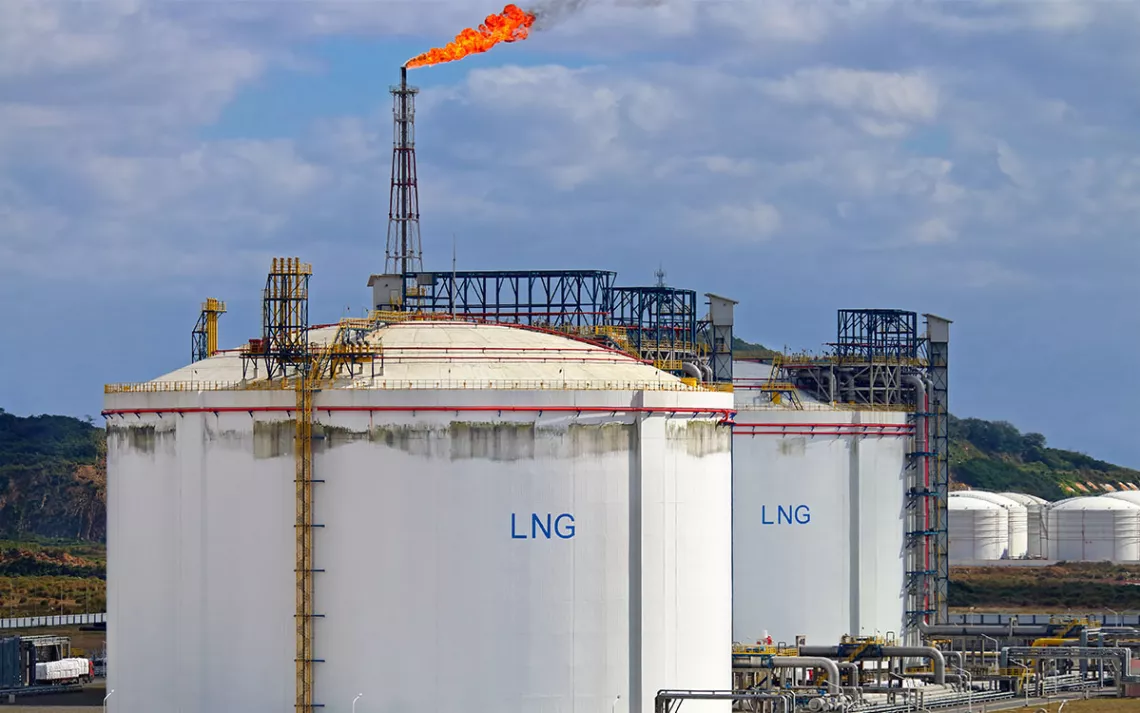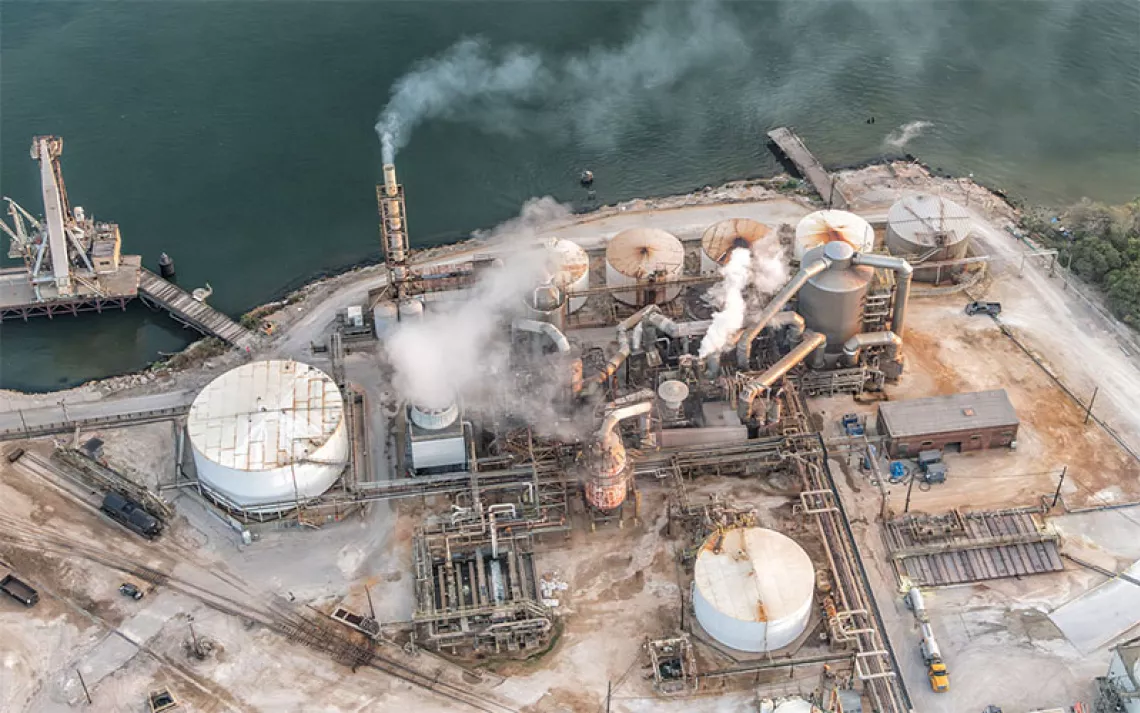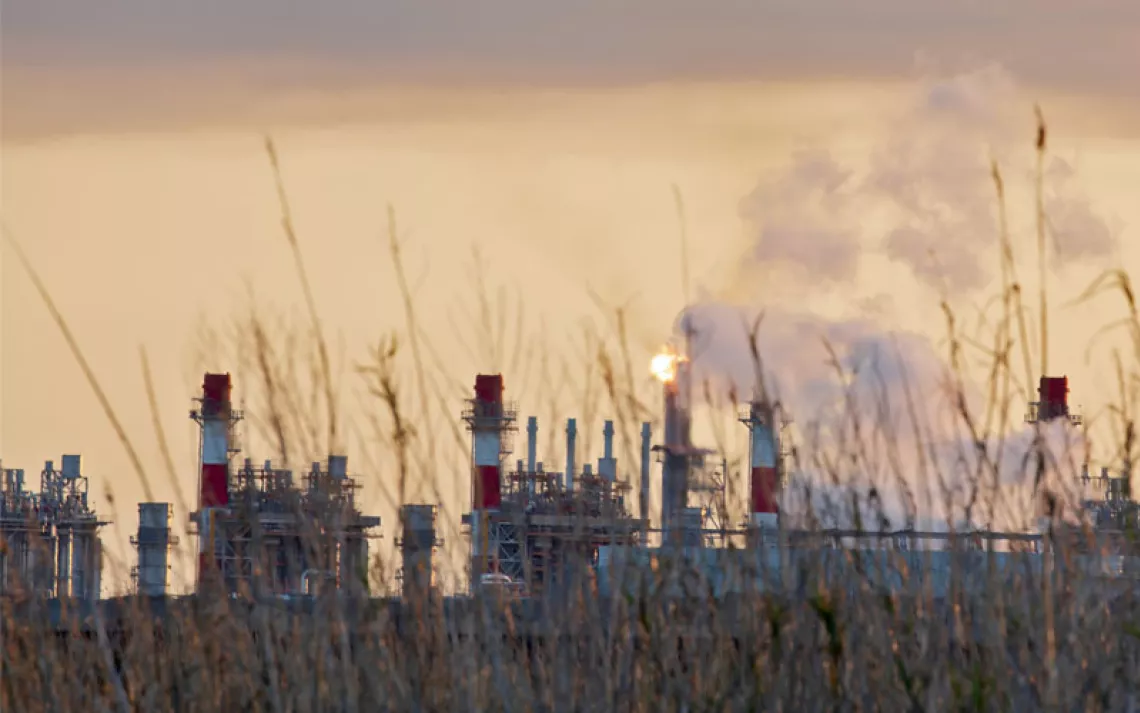The LNG Industry Claims to Be a Climate Solution. Here Is the Reality.
Here's what you need to know about liquefied natural gas

Photo by Sky_Blue/iStock
This article originally published in Canary Media.
American liquefied natural gas exports surged from basically nothing just eight years ago to a formidable force reshaping domestic and global politics. Now, thanks to the Biden administration’s recent pause on approvals of new LNG projects, it’s become the hottest topic in US energy news. It’s also one of the most confusing.
Different interest groups promote wildly divergent ideas about the impacts of LNG at home and abroad. It’s harming American consumers, or it’s not. It’s a wildly destructive “carbon bomb,” or it’s helping the climate by displacing dirtier power plants overseas. Europe gets enough US gas to be secure, or it desperately needs more LNG flowing from the United States.
LNG is, at core, a profit-making venture carried out by a handful of large companies and their financiers. These corporations don’t get graded on how well they bolster American allies or obviate the need for new coal plants, yet those outcomes loom large in the rhetorical arguments made on behalf of this young industry.
The Biden administration’s pause, which could last through the upcoming presidential election, has kicked up a whole new flurry of discussion. We scoured the available evidence to stress-test the most prominent claims being made about LNG and clarify what’s credible, what’s contested, and what looks dubious.
Are LNG exports a tool of American foreign policy?
LNG frequently gets wrapped in patriotic rhetoric. None other than President Joe Biden pledged to increase LNG exports to help Europe after the Ukraine invasion. LNG spokespeople similarly conjoin the industry’s interests with the strategic aims of the United States, as when American Petroleum Institute CEO Mike Sommers recently labeled the pause on new permits “a win for Russia and a loss for American allies.”
But it’s important to bear in mind that LNG exports are a business transaction conducted by profit-maximizing companies. If they choose to export to places that the US government wants to support, that commerce may line up with foreign policy goals. But geopolitics does not dictate the flow of gas; markets do.
“The US government can’t say where [LNG] is going to head—it’s based on pricing dynamics and demand,” said Nnenna Amobi, a European gas analyst at BloombergNEF. “There’s still competition between Europe and Asia to receive gas. Wherever it’s more profitable is where that cargo tends to go.”
In fact, much of US LNG export capacity is currently earmarked for Asian buyers via long-term contracts. Some of those Asian buyers, particularly Japanese companies, own stakes in the US LNG projects built to supply them, Amobi noted. The interconnected gas markets in Europe, on the other hand, only hold long-term contracts to supply about one-third of its LNG needs, so European countries have to buy the rest on the open market.
The response to Russia’s invasion of Ukraine, in which the LNG industry seemingly rallied behind Biden’s pledge of support for his allies, was really a case of Europe temporarily paying top dollar to divert shipments headed to other places. This happened to coincide with weak demand in Asia as economies there were still dealing with Covid; contract holders could resell to Europe at exorbitant markups.
The upshot: Sometimes the business incentives of LNG companies align with US foreign policy goals, but US foreign policy does not dictate shipments of LNG.
Does pausing approvals for new LNG terminals compromise Europe’s ability to move off Russian gas?
LNG advocates have argued that Biden’s freeze on approvals for new LNG projects threatens European energy security. To assess that risk, we need to examine where Europe stands today.
The European Union got roughly 40 percent of its fossil gas from Russia prior to the invasion of Ukraine in early 2022. After that, Europe needed to find other options, fast, to stop depending on the goodwill of a war-mongering authoritarian. US LNG exports sent to Europe roughly tripled from 2021 to 2023, according to recent testimony from industry group Eurogas to the US Senate.
“US LNG is a critical factor, and that isn’t going to change anytime soon,” Amobi said. US LNG has surged to make up about 50 percent of Europe’s inbound supplies, per BloombergNEF data. The only country sending more gas to Europe is Norway, via pipeline (these data points refer to the interconnected market spanning northwest Europe, Italy, and Austria, not the entire continent).
But Europe also built record amounts of renewables after the invasion, cutting into gas demand from the power sector. Heat pumps displaced gas heaters for space heating. Some industrial companies dialed back activity due to high gas prices. Two fortuitously warm winters also helped lower demand.
Those combined factors have changed Europe’s energy situation considerably since spring 2022, and it’s hard to say the gas market is still in crisis. Europe rode into this winter with gas storage facilities filled to the brim, and prices have declined significantly since the early days of the war.
Nevertheless, the EU still imported nearly 50 billion cubic meters (bcm) from Russia in 2023, about a third of prewar levels, according to Eurogas (the European trade group also includes several of the largest US LNG companies). For comparison, Europe now imports 60 bcm of US LNG.
The EU is working toward imposing an embargo on Russian gas by 2027 (it banned Russian oil already), so it will need to replace that missing energy source. Meanwhile, LNG demand is growing in South and East Asia.
In short, Europe’s current equilibrium on gas supplies might not prove sturdy. “There’s still risk in the market,” said BloombergNEF’s Amobi. More US LNG shipments could help complete the phaseout of Russian gas and buffer against supplies getting pulled to other parts of the world.
More US LNG is already on the way. Seven new LNG export terminals have been approved by the Federal Energy Regulatory Commission and begun construction, enough to more than double existing capacity once they are up and running. Another 11 have been approved by FERC but haven’t begun construction. None of these will be impacted by the Biden administration’s pause. But, again, the exporters have already allocated much of this forthcoming capacity to Asia.
The upshot: The earlier-stage developments that are stymied by the pause weren’t expected to show up until the end of the decade anyway, so the pause does not change Europe’s near-term energy supply. It could, however, be felt in the late 2020s and into the 2030s.
Do LNG exports raise or lower energy prices for American consumers?
Industry-funded gas advocate Natural Allies for a Clean Energy Future praises gas for “ensuring affordability and reliability while reducing carbon emissions domestically and internationally.”
Certainly, the US LNG boom has helped make energy more affordable in Europe. But now American consumers increasingly compete with European and Asian buyers willing to pay far more for the same commodity. That’s great news for LNG companies, but not so helpful for regular Americans.
Since the shale revolution, the US has had abundant gas sloshing around within its borders, making gas power plants and heating very cheap. Each new LNG export terminal takes some of that gas away, and the scale keeps growing. In December, Lower 48 production of consumer-grade fossil gas hit an all-time monthly high of 105.5 billion cubic feet per day (bcfd); that same month, LNG terminals received 14.7 bcfd, roughly 14 percent of that production.
The Department of Energy under President Trump concluded in a 2018 study that when the US exports more gas, “households will pay higher prices for the natural gas that they use (e.g., for heating and cooking).” Similarly, industries that use a lot of gas, like the electricity sector, “will experience increases in their cost of production.”
But that study ultimately concluded that the American economy overall would benefit from LNG exports. For instance, those exports would attract foreign capital and raise the value of the dollar, thus making foreign products incrementally more affordable for all Americans. The study also concluded that “households who hold shares in companies that own liquefaction plants” will benefit from the growth of exports. Numerous consumer advocates have since derided the study’s accounting, since the stock market benefits aren’t distributed to the many households struggling to pay higher energy bills.
Nevertheless, the relationship between LNG exports and domestic gas prices is complex. Right now, with LNG exports at an all-time high, gas prices have fallen very low again. The Henry Hub spot price has been kicking around close to $2 per MMBtu for weeks. That’s because the US produces more gas than ever before; December set a monthly all-time record, per the EIA.
Gas production in 2016, at the dawn of the LNG era, averaged 72.3 bcfd; it has since grown by more than the amount that’s exported as LNG. The lure of foreign markets clearly played a role in gas companies’ expansion plans. But we don’t know what would have happened in a world without an LNG bonanza; extraction could have grown anyway due to the sheer ingenuity of the energy industry, or demand from resurgent US manufacturing, or the coming boom in Gulf Coast hydrogen production.
The upshot: Record production today mitigates gas price increases from exports. But gas has become an internationalized commodity, much like oil, making American energy consumers more vulnerable to global shocks. The Americans most exposed to future price spikes are the most dependent on gas for power and heat (and with the lowest allocation of LNG stocks in their portfolios).
Do LNG shipments replace more carbon-intensive fuels?
LNG supporters tout it as a win for climate, pointing to the pivotal role natural gas played in dethroning King Coal from the US grid. As trade group API put it in its protest of the LNG pause: “US LNG is critical for accelerating global emissions reductions by displacing higher-emitting fuels.”
There’s one problem with that: There’s no guarantee that LNG shipments actually displace coal.
“There’s really been no mechanism in place to ensure that [exports] displace dirtier sources and not cleaner sources,” said Max Sarinsky, an adjunct professor at New York University School of Law.
While there has been much chatter about Germany temporarily firing up old coal plants to avoid energy shortfalls, American LNG is largely displacing gas from Russia (which comes by pipeline and LNG). That’s swapping gas for gas.
Could Germany burn less coal if it received more US LNG? In theory, certainly. Current low gas prices in Europe put gas plants in the money relative to coal plants, according to BloombergNEF’s data.
But power-sector expansion isn’t a two-way contest between coal and gas. If Germany hadn’t brilliantly decimated its own carbon-free nuclear power fleet and bet on Russian pipelines, it wouldn’t need so much coal or gas right now. Building record numbers of wind and solar plants also reduces the shortfall that fossil fuels need to fill.
If LNG has shut down any coal plants, the LNG industry should be able to furnish an example. But this isn’t the reason why LNG exporters got into the business.
The upshot: There’s no guarantee that LNG will be shipped to places where it can verifiably displace coal. Any reduction of foreign fossil fuels is incidental to the effort to make money selling American fossil fuels.
Is LNG cleaner than other fossil fuels?
Even if LNG displaced coal somewhere, would that be a win for the climate? Just about any LNG booster asserts that it would.
Coal burns dirtier than gas, and the US power sector cut emissions considerably by swapping coal plants for gas plants. Nowadays, that swap doesn’t look as good as it used to, because researchers have found more methane leaking from the gas supply chain than previously thought, and unburnt methane produces a warming effect many times stronger than carbon dioxide.
LNG is an especially carbon-emitting form of gas. Beyond background leakage in the gas supply chain, LNG terminals consume vast amounts of energy for liquefaction and regasification. In between, tankers consume fossil fuels to move LNG across the seas. To truly mitigate the climate crisis, LNG’s considerable life-cycle emissions need to clock in below whatever power source it offsets.
This is an empirical question, but tracking invisible gases across continents and oceans is a tricky business. Scientific understanding of LNG emissions-intensity remains, predictably, contested.
A 2019 DOE study estimated that European power plants burning US LNG produce lower life-cycle emissions than burning European coal or Russian pipeline gas (those leaky Russian pipes!). But LNG emits considerably more than coal, according to a new study by Robert Howarth, a professor of ecology and environmental biology at Cornell University. This study is still going through peer review, but it was released early amid public debate over new LNG approvals.
Haworth assumes 2.6 percent of natural-gas production leaks from the field, based on the mean rate in his own recent synthesis of measurements at US shale operations. Leakage rates are something of a moving target, though: If particular projects leak less than 2.6 percent, they’ll produce cleaner LNG. The US is implementing new rules to crack down on this leakage; the Biden administration touted that regulatory action at COP28 last year. Fifty oil and gas companies around the world have pledged to lower leakage to 0.2 percent by 2030.
Another big emissions driver is the energy required to convert gas to and from its liquid state. Haworth surmises from empirical studies that terminals typically combust the equivalent of 9.8 perceny of the gas they’re liquefying to power liquefaction. But many US terminals chose to buy power from the grid to run these operations, which can consume hundreds of megawatts, depending on size.
Process electricity should be the easiest place to cut carbon emissions: Exporters just need to buy clean electricity for their terminals. The biggest tech giants have been doing this for years to power data centers cheaply while burnishing climate-friendly credentials, even if in practice they depend on fossil-fueled power at certain hours. There’s no reason LNG companies couldn’t strike similar deals with Texas wind and solar farms.
LNG advocate Rodrigo Sandoval, who runs a group called LNG Cluster, hopes terminal operators in Texas will consider power-purchase agreements to secure some of the state’s cheap, abundant renewable power to run their export operations.
“I’m trying to help them understand the opportunities that they have,” Sandoval said. “They could buy more clean energy and make their process cleaner with those kinds of PPAs, and they could tell the story like Microsoft or Walmart.”
So far, the renewable PPA, the fundamental building block of modern clean power markets, remains a foreign concept for the LNG industry.
The upshot: Gas burns cleaner than coal, but LNG creates substantial emissions from extraction to delivery at power plants. Tackling upstream gas emissions will be crucial to lowering the climate impact. The industry has yet to attempt achievable emissions reductions from clean electricity procurement, which is commonplace among other large American businesses.
 The Magazine of The Sierra Club
The Magazine of The Sierra Club



